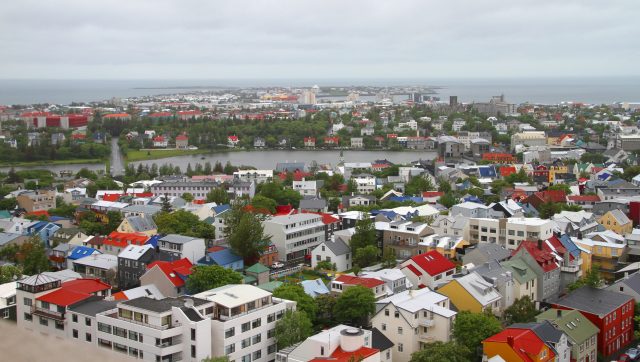
European Diary: Reykjavik, December 2021
The name of Iceland’s capital Reykjavik is in English ‘Smoke Bay’. The place received the name in 874 from the first settler in Iceland, Ingolf Arnarson from the west of Norway, after he arrived at a bay in the southwest of Iceland and saw steam columns rise from hot springs there. He decided to establish a farm on the spot. For the next nine centuries, Reykjavik was just one of the around five thousand farms scattered on Iceland’s coastline, until a village began slowly to form there in late eighteenth century. Iceland had been an independent Commonwealth from 930 to 1262 after which she became a tributary of the Norwegian king. In 1380, the Norwegian crown was inherited by the king of Denmark, and after that Iceland was ruled from the Danish capital, Copenhagen. Almost all officials in Iceland were however Icelandic and in the nineteenth century they settled mostly in Reykjavik. Moreover, when the Danish king in 1843 restored the Icelandic parliament it was convened in Reykjavik and not at its old site in the Icelandic countryside. Thus, when the Danes granted Iceland home rule in 1904, Reykjavik was already the unofficial capital of Iceland, then still a Danish dependency. In 1918, however, Iceland became a sovereign country in a personal union with the Danish king, with Reykjavik as her capital, which the city remained when a republic was proclaimed in 1944.
A Clean, Green, and Safe City
Reykjavik is the world’s northernmost capital of a sovereign country, and it is the westernmost sizeable European city, a true European outpost. Today, it is one of the cleanest, greenest, and safest cities on earth: after all, Iceland has the lowest poverty rate of all countries, the greatest income equality, and one of the lowest crime rates. One reason the city is so clean is that it need not burn any fossil fuels to heat its houses. Instead, since the 1930s and 1940s hot water from nearby thermal springs have been used for that purpose, passing into a vast network of pipes and on to simple radiators in each building. The pioneer in this ingenious use of Iceland’s vast thermal resources was civil engineer and entrepreneur Jon Thorlaksson, who was Prime Minister for a while and later Mayor of Reykjavik. He was the founder and first leader of Iceland’s conservative-liberal Independence Party, and in 1992 I published his biography commissioned by Reykjavik’s geothermal utility.
Snorri’s Two Political Ideas
It was in Reykjavik on 2 December 2021, at a seminar held by the University of Iceland Centre for Medieval Studies, that I read a paper on the Icelandic chronicler Snorri Sturluson as an early proponent of the conservative-liberal tradition in politics. Snorri (1179–1241) is probably the most famous Icelander of all times, the author of the acclaimed Edda, on Nordic mythology and poems, Heimskringla, the history of the Norwegian kings, and Egil’s Saga, one of the best Icelandic sagas. In my paper, I pointed out that in Heimskringla (probably written between 1220 and 1237) Snorri clearly sympathised with two political ideas of the Middle Ages, that kings were subject to the law like everybody else and that if they broke the law, they could be deposed. Indeed, Snorri went further and said in a speech that he put into the mouth of Icelandic farmer Einar from Thvera in 1024 that since kings were uneven, some good and some bad, it was best to have no king, as was the case in Iceland during the Commonwealth.
The First Individual?
Moreover, Egil’s Saga by Snorri can be read as a celebration of individuality: the warrior-poet Egil Skallagrimsson was one of the first genuine individuals to step out of the mists of family, tribe, and region. According to Lord Acton, St. Thomas Aquinas was the first Whig, but arguably it was rather Snorri who deserved that epithet. Likewise, Jacob Burckhardt had taught that individuality first emerged in Renaissance Italy, but a case could be made that it emerged with Egil, who had a rich inner life, expressed in his poems. I suggested that the Icelandic sagas were written when the Icelanders, challenged by Norway, had to reaffirm their national identity. Probably Egil’s Saga was written in 1239–1241, after Snorri’s second visit the Norwegian Court where he fell out with the king. Finally, I wondered whether Snorri’s political programme, to maintain friendly relations with Norway without Iceland becoming a tributary of the Norwegian king, was feasible at the time. I recalled that in late thirteenth century, what is now Switzerland was forming in the Alps, an independent country without a king. The Swiss never succumbed to foreign potentates. If the Swiss could do it, why not the Icelanders?
Comments by a Critic
History Professor Sverrir Jakobsson commented on my paper. He conceded that liberal or anti-royalist sentiments could be detected in Heimskringla, but he questioned whether Snorri was in fact the author of Egil’s Saga, adding that in his lifetime Snorri did not really behave as an opponent of the Norwegian king. I responded that the main source on Snorri’s life, his cousin Sturla Thordson, also a well-known chronicler, seemed biased against him. It should be recalled, also, that Snorri was of course not hostile to the Norwegians. He wanted friendly relations with them, but not servitude under them.



 Subscribe
Subscribe